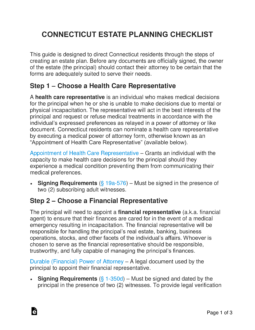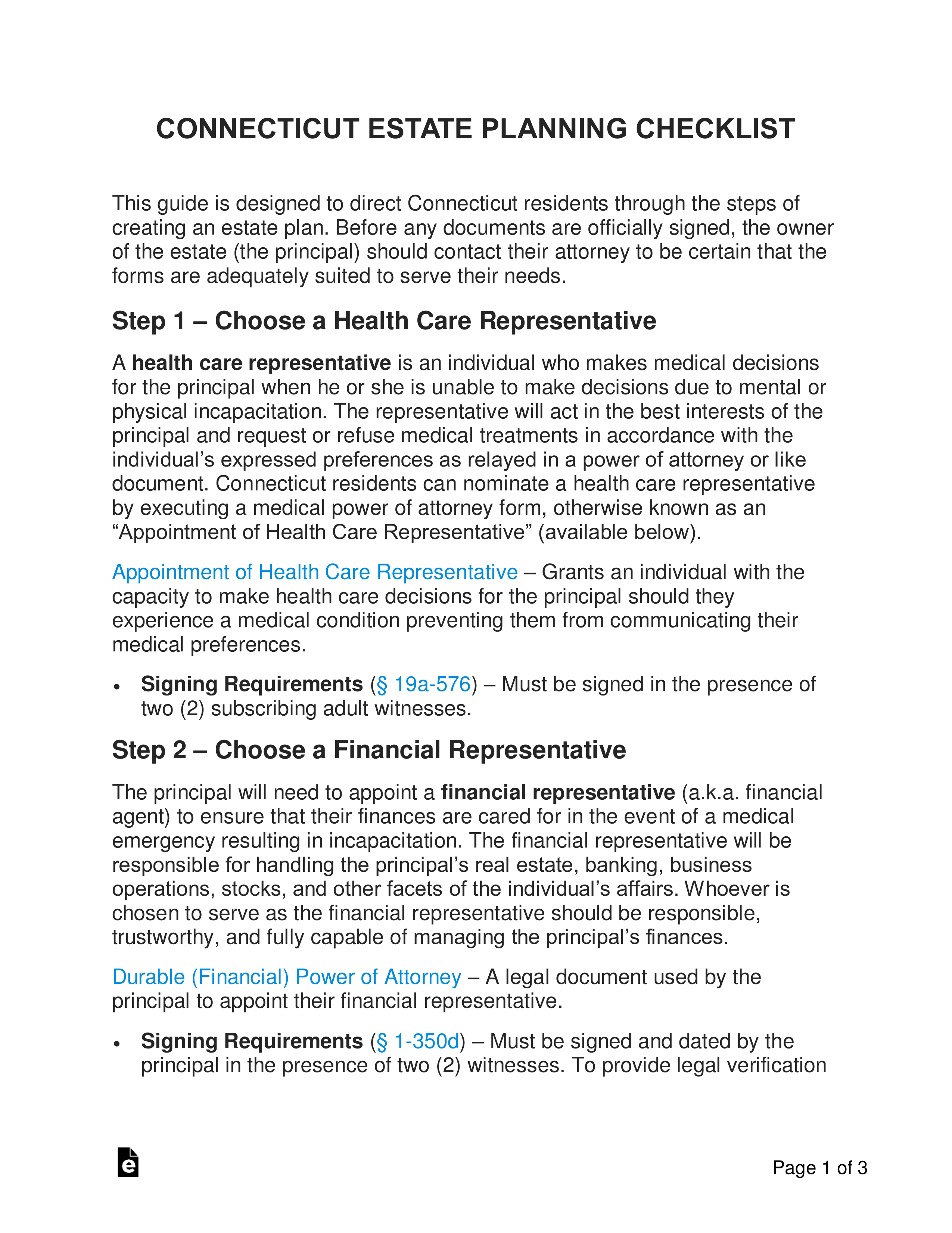Updated March 05, 2024
A Connecticut estate planning checklist is a task list full of valuable information for those seeking to secure their assets and prepare their estate for distribution after death. The checklist informs residents on how they can define the health care and financial actions they wish to be administered in medical emergencies. To prepare for such scenarios, individuals will need to complete an Appointment of Health Care Representative and a Durable (Financial) Power of Attorney. When determining how assets shall be transferred to beneficiaries, individuals will complete a Will and/or a Living Trust.
How to Create an Estate Plan in Connecticut (6 steps)
- Choose a Health Care Representative
- Choose a Financial Representative
- Itemize Assets in the Estate
- Notify Beneficiaries
- Decide How the Estate Shall be Transferred
- Store Estate Documents
This guide is designed to direct Connecticut residents through the steps of creating an estate plan. Before any documents are officially signed, the owner of the estate (the principal) should contact their attorney to be certain that the forms are adequately suited to serve their needs.
1. Choose a Health Care Representative
A health care representative is an individual who makes medical decisions for the principal when he or she is unable to make decisions due to mental or physical incapacitation. The representative will act in the best interests of the principal and request or refuse medical treatments in accordance with the individual’s expressed preferences as relayed in a power of attorney or like document. Connecticut residents can nominate a health care representative by executing a medical power of attorney form, otherwise known as an “Appointment of Health Care Representative” (available below).
Appointment of Health Care Representative – Grants an individual with the capacity to make health care decisions for the principal should they experience a medical condition preventing them from communicating their medical preferences.
- Signing Requirements – Must be signed in the presence of two (2) subscribing adult witnesses.[1]
2. Choose a Financial Representative
The principal will need to appoint a financial representative (a.k.a. financial agent) to ensure that their finances are cared for in the event of a medical emergency resulting in incapacitation. The financial representative will be responsible for handling the principal’s real estate, banking, business operations, stocks, and other facets of the individual’s affairs. Whoever is chosen to serve as the financial representative should be responsible, trustworthy, and fully capable of managing the principal’s finances.
Durable (Financial) Power of Attorney – A legal document used by the principal to appoint their financial representative.
- Signing Requirements – Must be signed and dated by the principal in the presence of two (2) witnesses. To provide legal verification that the document is valid, the principal should sign and acknowledge the signature in the presence of a notarial officer.[2]
Financial Powers Allowed
- Real Property[3]
- Tangible Personal Property[4]
- Stocks and Bonds[5]
- Commodities and Options[6]
- Banks and Financial Institutions[7]
- Operation of Entity or Business[8]
- Insurance and Annuities[9]
- Estates, Trusts, and Other Beneficial Interests[10]
- Claims and Litigation[11]
- Personal and Family Maintenance[12]
- Benefits From Governmental Programs or Civil or Military Service[13]
- Retirement Plans[14]
- Taxes[15]
3. Itemize Assets in the Estate
Before the principal creates a document that communicates how their estate will be distributed after they die, it would be best if they drafted a document that lists and describes their current assets. Doing so will expedite the process of allocating specific assets to the beneficiaries as well as the process of distributing the estate following the principal’s death.
Current Assets List – Contains the framework necessary to itemize and describe one’s assets.
4. Notify Beneficiaries
5. Decide How the Estate Shall be Transferred
One of the most important aspects to take into consideration when preparing one’s estate is the manner in which assets will be transferred following the individual’s death. Depending on the individual’s preferences, they can use either or both of the following documents to communicate their preferences regarding the division of assets.
Last Will and Testament (‘Will’) – A legally binding document that specifies the designated beneficiaries along with the assets each individual is entitled to receive. The last will and testament will be subject to review in the probate court upon the principal’s death. What this means is that the distribution of the principal’s estate may only occur after a potentially lengthy and costly court proceeding.
- Signing Requirements – Required to be signed by the principal and two (2) witnesses.[16]
Revocable Living Trust – This document allows the principal to create an entity to which ownership of assets can be transferred. During the principal’s lifetime, they can continue to manage the assets and benefit from their property. The principal can also appoint another individual to act as trustee and assume the responsibility of managing the assets until the principal’s death. Creating a living trust can be a relatively complicated process in comparison to the creation of a last will and testament. However, a living trust will avoid probate proceedings after the principal dies, meaning that the assets held by the trust can be transferred to the beneficiaries without delay or additional fees.
- Signing Requirements – This form should be signed by the principal in the presence of two (2) witnesses and a notarial officer.
6. Store Estate Documents
Connecticut Estate Planning Laws
- Appointment of Health Care Representative – Chapter 368w
- Durable (Financial) Power of Attorney – Chapter 15c
- Last Will and Testament – Chapter 802a
- Revocable Living Trust – Chapter 802c


